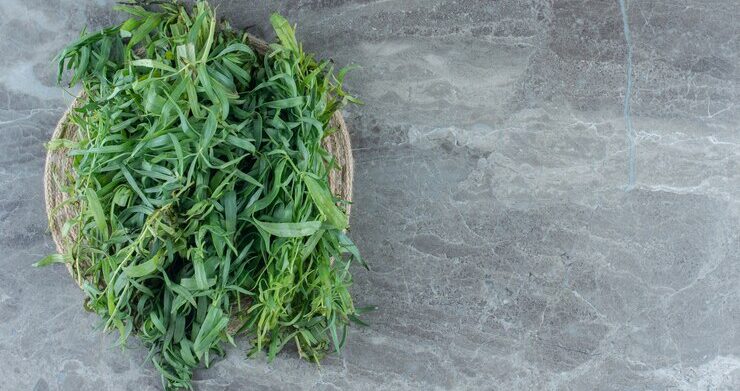Table of Contents
Ever been in the middle of cooking and wondered, “Wait, does tarragon taste like oregano?” 🤔 You’re not alone! These two herbs might sit next to each other on the spice rack, but their flavors are worlds apart. Let’s dive deep into what makes these culinary powerhouses unique, and how you can use them to level up your cooking game.
Tarragon and Oregano
What Are Tarragon and Oregano?
Tarragon and oregano are both herbs that pack a serious punch in the kitchen. But here’s the thing: they come from totally different plants! Tarragon, with its thin, delicate leaves, is part of the sunflower family 🌻, while oregano, with its small, oval leaves, belongs to the mint family 🌱. Both are staples in their own right, but they shine in very different dishes.
Origins and Historical Uses of Tarragon and Oregano
Tarragon has its roots in Eurasia, particularly in France, where it’s earned a special place in French cuisine. In fact, it’s one of the “fines herbes,” a blend of parsley, chives, chervil, and tarragon, used to season delicate dishes. Oregano, on the other hand, comes from the sunny Mediterranean. Ancient Greeks and Romans adored oregano for its bold flavor and even believed it had medicinal properties. 🌍
“Tarragon whispers; oregano shouts.” – Old culinary adage
Culinary Importance of These Herbs
Both herbs are essential in different kitchens. Tarragon’s anise-like flavor makes it perfect for creamy sauces, fish, and chicken dishes, while oregano is the star of pizza, pasta, and just about anything Italian. Imagine biting into a margherita pizza 🍕 without that sprinkle of oregano – it’s just not the same, right?
Flavor Profile Comparison: Tarragon vs. Oregano
What Does Tarragon Taste Like?
If you’ve never tasted tarragon, imagine something sweet, slightly licorice-like, with a hint of bitterness. It’s subtle, sophisticated, and almost delicate. Tarragon works its magic best in lighter dishes where its flavor can shine without being overpowered.
What Does Oregano Taste Like?
Oregano, on the other hand, is bold and earthy with a hint of bitterness. It has a slightly peppery kick that makes it a staple for robust dishes. Think of oregano as the life of the party, while tarragon is the calm, elegant friend sipping tea in the corner. 🍵
Key Flavor Differences Between Tarragon and Oregano
So, do they taste alike? Not really. Tarragon’s sweetness and anise notes are miles apart from oregano’s peppery and earthy punch. It’s like comparing a soothing herbal tea to a strong espresso ☕ – both are great, but for totally different reasons.
Common Uses of Tarragon and Oregano in Cooking
Popular Recipes Featuring Tarragon
Tarragon is a superstar in French cuisine. Ever tried béarnaise sauce? That creamy, buttery delight owes its distinct flavor to tarragon. It’s also amazing in chicken salads, fish dishes, and even scrambled eggs! 🐓🐟
| Recipe | Main Ingredients |
|---|---|
| Béarnaise Sauce | Butter, egg yolks, tarragon, white wine vinegar |
| Tarragon Chicken | Chicken breast, tarragon, cream, Dijon mustard |
| Tarragon Fish | White fish, tarragon, lemon, olive oil |
Popular Recipes Featuring Oregano
Oregano is a go-to for Italian and Mediterranean cooking. From pizza to Greek salads, oregano brings a bold, earthy flavor that screams comfort. If you haven’t sprinkled oregano over a steaming bowl of spaghetti, you’re seriously missing out! 🍝
| Recipe | Main Ingredients |
|---|---|
| Margherita Pizza | Tomato sauce, mozzarella, oregano |
| Greek Salad | Cucumber, tomato, feta, oregano |
| Oregano Roasted Potatoes | Potatoes, olive oil, oregano, garlic |
Can Tarragon Substitute Oregano or Vice Versa?
Here’s the tricky part: tarragon and oregano don’t make the best substitutes for each other. Their flavors are just too different. However, if you’re in a pinch, you can try using other herbs like basil for oregano or fennel for tarragon. It won’t be identical, but it’ll get the job done. 🌿
The Science Behind Their Flavors
Essential Oils and Chemical Compounds
So, why do tarragon and oregano taste so different? It all comes down to their essential oils. Tarragon is rich in estragole, which gives it that sweet, anise-like flavor, while oregano owes its bold taste to carvacrol and thymol. Think of these compounds as the secret ingredients in their flavor potion. 🧪✨
Why Do Tarragon and Oregano Taste Different?
It’s all about the plant families they come from. Tarragon’s sunflower ancestry leans toward a sweeter, more aromatic profile, while oregano’s minty roots bring out its earthy, peppery vibe. It’s like they were born to star in completely different genres of culinary shows. 🎭
Common Problems When Using Tarragon or Oregano
Overpowering Dishes with Tarragon or Oregano
Here’s the thing about tarragon and oregano—they can easily steal the show if you’re not careful. Ever dumped too much oregano on a pizza? It’s like the herb stage-crashed and grabbed the mic. Tarragon, on the other hand, can turn a dish too sweet if overused. Pro tip: always start small and taste as you go! 👩🍳
Confusion Between the Two Herbs in Recipes
It happens to the best of us. You’re making a recipe, grab the wrong herb, and suddenly your Italian pasta tastes like French fish. If you’re not sure, smell them before adding. Tarragon smells sweet and licorice-like, while oregano hits you with a bold, earthy aroma. Nose knows best! 👃
What to Do If You Don’t Like Tarragon or Oregano?
Not a fan? No worries. If tarragon isn’t your thing, try swapping it with dill or fennel for a similar vibe. If oregano’s too intense, basil or thyme might be your new best friends. Cooking is all about experimenting until you find your flavor groove! 🎨
Practical Tips for Using Tarragon and Oregano
How to Choose Fresh or Dried Tarragon and Oregano
Fresh or dried—what’s the better choice? Fresh herbs are great for delicate dishes, while dried ones pack a concentrated punch. Look for bright green leaves on fresh tarragon, and a deep green or brownish tone for dried oregano. If it smells amazing, it’s probably good to go! 🌿
Best Storage Practices for These Herbs
Want to keep your herbs fresher for longer? Store fresh tarragon and oregano in the fridge, wrapped in a damp paper towel. For dried herbs, seal them in an airtight container and keep them in a cool, dark spot. A little care goes a long way to keeping those flavors alive. 🫙
Combining Tarragon and Oregano with Other Ingredients
Pairing these herbs with the right ingredients can make all the difference. Tarragon loves creamy and citrusy flavors, while oregano is all about tomatoes, garlic, and olive oil. Imagine tarragon dancing with lemon in a buttery sauce or oregano rocking out with a tomato-based pizza topping. Match made in heaven! 🍅🍋
Tarragon and Oregano in Global Cuisines
Tarragon in French and European Cuisine
Tarragon is a must-have in French cooking. From béarnaise sauce to tarragon-infused vinegar, it’s a key player in elevating dishes to gourmet status. Fun fact: in Russian cuisine, tarragon is even used to flavor a bright green soda called “Tarhun.” Fancy and fun, right? 🥂
Oregano in Mediterranean and Latin American Cuisine
Oregano is the backbone of Mediterranean dishes. Think Greek salads, Italian pizzas, and Spanish tapas. But don’t stop there—oregano also shines in Latin American cuisine, adding bold flavor to tacos, enchiladas, and marinades. It’s like oregano has a passport stamped in all the tastiest places! ✈️
Health Benefits and Nutritional Value
Nutritional Value of Tarragon
Tarragon may be small, but it’s mighty! It’s low in calories and packed with essential nutrients like manganese, iron, and calcium. Plus, it’s rich in antioxidants that help fight free radicals in your body. Who knew a little herb could do so much? 🌟
| Nutrient | Per 2 Tsp (Fresh) |
|---|---|
| Calories | 5 |
| Iron | 0.8 mg |
| Calcium | 16 mg |
| Vitamin A | 70 IU |
Nutritional Value of Oregano
Oregano is a nutrient-packed powerhouse too! It’s high in fiber, vitamin K, and manganese, making it great for bone health and digestion. Plus, its antimicrobial properties can give your immune system a little boost. Add oregano, stay healthy! 💪
| Nutrient | Per 1 Tsp (Dried) |
|---|---|
| Calories | 3 |
| Fiber | 0.8 g |
| Vitamin K | 11.2 mcg |
| Calcium | 29 mg |
Are Tarragon and Oregano Good for You?
Absolutely! Tarragon is often used to help with digestion and sleep, while oregano is a natural antibiotic and anti-inflammatory. Whether you’re adding them for flavor or health benefits, your body (and your taste buds) will thank you. 🥗
Last Bite
Final Thoughts on Their Flavor Profiles
So, does tarragon taste like oregano? Not at all! Tarragon’s sweet, anise-like notes are a stark contrast to oregano’s bold, earthy punch. But that’s what makes them so special—they each bring their own magic to the table.
How to Experiment with Both Herbs in Your Kitchen
Here’s the fun part: experimenting! Try tarragon in creamy sauces or herb-infused oils, and sprinkle oregano on pizzas, pastas, or even roasted veggies. Cooking is all about discovering what works for your palate, so get creative and let your taste buds lead the way. 🎉
At the end of the day, these two herbs are culinary treasures, each with their own charm. Whether you’re team tarragon or team oregano, there’s no wrong answer—just delicious possibilities! 🍴✨
“Try this Tarragon Lemon Roast Chicken—because nothing says ‘fancy dinner’ like your chicken tasting like it just came back from a spa day with a citrusy herb rub!” 🍋🐓✨

